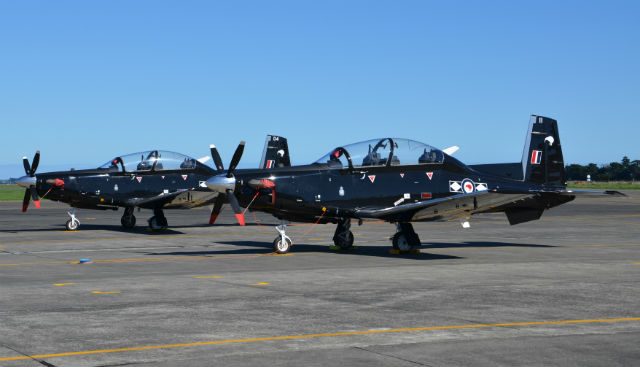Flightglobal contributor Peter Clark was given the opportunity to fly in one of the Royal New Zealand Air Force’s (RNZAF) newly-operational Beechcraft T-6C trainers, during a 42min sortie from Ohakea air base.
Eleven T-6Cs are being used to deliver initial training to students, with the new capability due to deliver 15 graduate pilots and 12 qualified flying instructors annually over the next 30 years. The Texan II airframes have replaced the RNZAF’s previous Pacific Aerospace CT-4E Airtrainers, the last of which were retired in December 2014.

Peter Clark
Ordered in January 2014 to meet the New Zealand Defence Force’s pilot training capability requirement, the T-6Cs were acquired as part of a $154 million package. This also covered the provision, via CAE Simulation, of two fixed-base flight simulators and classroom and computer-based training equipment, plus a mission planning and debriefing suite.
In addition to the T-6C’s ejection seats, collision avoidance and terrain awareness warning systems, New Zealand’s examples have unique equipment including a GPS-enabled emergency locator transmitter, a “Track Plus” flight monitoring system and smoke kits for use during aerobatic displays.
The RNZAF’s first pair of T-6Cs landed at Ohakea on 21 August 2014, following a 26-leg transfer from Wichita, Kansas. They were officially handed over to the service in late October the same year, and its final two examples arrived in April 2015.
By November, the air force and its 14 Sqn had completed the fifth and final phase of a Texan trials and development activity, covering advanced standard operating procedures, including low-level and formation aerobatics.
With an initial 12 personnel having completed a flying instructors course, 14 Sqn started training in February, with an initial intake of 10 students. This first Wings course is planned to take between 15 and 18 months to complete, with a second to begin in July or August, with up to 12 students.
The RNZAF’s Central Flying School, with five instructors, has prepared the training syllabus, and will maintain standards.
In all, New Zealand’s T-6Cs have completed just over 2,000 sorties. New Zealand’s Safe Air and CAE Australia are providing logistics support.
Source: FlightGlobal.com
















